We all have lists of our networks, whether its mobile contacts, customers or an Excel file of 1000 email contacts.
Managing email lists takes some effort and time to keep your contact database organized.
So how can you organize your email database in a way that saves your time and help you send emails to specific segments?
Proper email list management is the way to get rid of messy Excel files, tons of lists and groups. And optimize your efforts to boost your email marketing performance.
With a well-managed email database, it will be easier for you to send personalized campaigns and create high converting automated email campaigns.
To help you manage your email lists, I’ll guide you through:
- What is list management
- Importance of email list management
- Email list management best practices
- How to build an email list
Let’s get to it.
What is List Management?
Email list management is the practice of managing your contact database in lists and segments. To keep your contacts organized based on their engagement and who they are:
- Blog subscribers
- Customers
- Trial users
- Lead magnet downloaders
- Etc.
You can also manage your contacts based on their behavior and interests. This way you’ll be able to send them content that resonates with their interests.
Importance of Email List Management
On your email list, you have contacts who subscribed to your list because they are interested in what you have to offer. They might benefit and learn from your offerings.
Yet, imagine you have a messy contacts’ database. And you want to send an email to specific contacts from your long Excel file.
How would you feel about that?
It might take you hours to extract the contacts you want to reach out to.

When your contact lists are disorganized, sending an email to a specific segment can be a nightmare of copying and pasting from your Excel files.
With proper email list management, you can turn that nightmare to a simple few clicks.
Keeping your email lists organized can save you a lot of time that you can spend on what is more important. Your email content.
Email Database Management Best Practices
Your email database is one of the most valuable elements of your business. Keeping it organized will expand your opportunities to send more personalized emails.
Emails that are based on your contacts’ information and segments.
Have a look at these best practices of email database management.
Segmentation
Effective email marketing is all about proper segmentation – every marketer knows that. The better you segment your audience the higher your ROI will be.
Segmentation is the practice of applying filters to make it easy to find a set of subscribers that have something in common.
Contact filtering can be based on:
- Age
- Specific ebook downloaders
- Paying customers
- Subscription date
- Contacts’ position
- Gender
- Geo-location
- Contacts’ engagement (Automatically added tags)
- And any other information your contacts shared with you.
Suppose you have an email database that includes more than a hundred CEOs you are interested in sending emails to for your B2B email campaigns.
You don’t need to create a separate email list for each segment. With an email list management software, you can create contact filters that allow you to target contacts based on their position.
Not only can you easily find people in your database, but you can also save them and reuse the same filter later.
Filters come in handy later if you want to only target the CEOs you have segmented.
You don’t have to send the same email to your whole list. You can send relevant offers based on contacts’ life-cycle stage, interest, geo-location and more.
Segmenting contacts based on their position is one thing, imagine what else you can use it for your email marketing.
Here is a case in which we create a filter based on:
- Position (CEO)
- Active status (Active)
- Email address (Doesn’t include gmail.com)
All together.
Creating filters to segment your contacts is one of the best email database management practices.
Instead of having multiple email lists, you can have one list and use filters to segment your contacts.
Having multiple lists is a notion that comes from old marketing technology. And it implies that you handle different sets of subscribers completely separately.
But marketing technology has improved. And now there is the option to filter your subscribers easily based on their different types of data, like geolocation, behavior, interest, life-cycle stage, age, and so on.
That’s the reason I recommend you to only use multiple email lists if your subscribers are absolutely different stakeholders. So you would never mix them.
Having fewer lists will help you segment and manage your subscribers more easily. And that’ll let you send timely and relevant emails to them.
So based on your goals, industry, and business model you can determine how many lists you’ll use. That’s why setting your goals is extremely important when you start your email marketing journey.
Use contact tags
You can be more precise with your email content by applying tags to contacts.
A contact tag is a label you add to an email contact that represents a certain detail. It can be:
- Purchased product
- Downloaded content
- Geolocation
- Attended event/webinar
- Clicked in an email
- Etc.
Tagging helps you:
- Avoid spamming your subscribers,
- Know what type of content they are interested in,
- Segment them according to their behavior,
- Identify their life-cycle stage.
Let’s say you run a travel agency business, and your contacts subscribe through a landing page.
You send the first email promoting two trips, one for a US vacation, and another for a Safari trip.
Obviously, your subscribers share different interests.
Some of them would click the US vacation link to read more details, and others would go for the Safari link.
What you have to do here is apply a contact tag based on the clicked link, this way you have a better understanding of their interests.
A tag “US vacation” for those who showed interest in the US, and a “Safari trip” tag to contacts who showed interest in the Safari trip.
This way you won’t follow up for both contact categories with the same email.
The point is…
If your subscribers are different why treat them all the same?
With Automizy’s automated conditions, you can base your follow-up emails on the contacts’ interests and send two different emails.
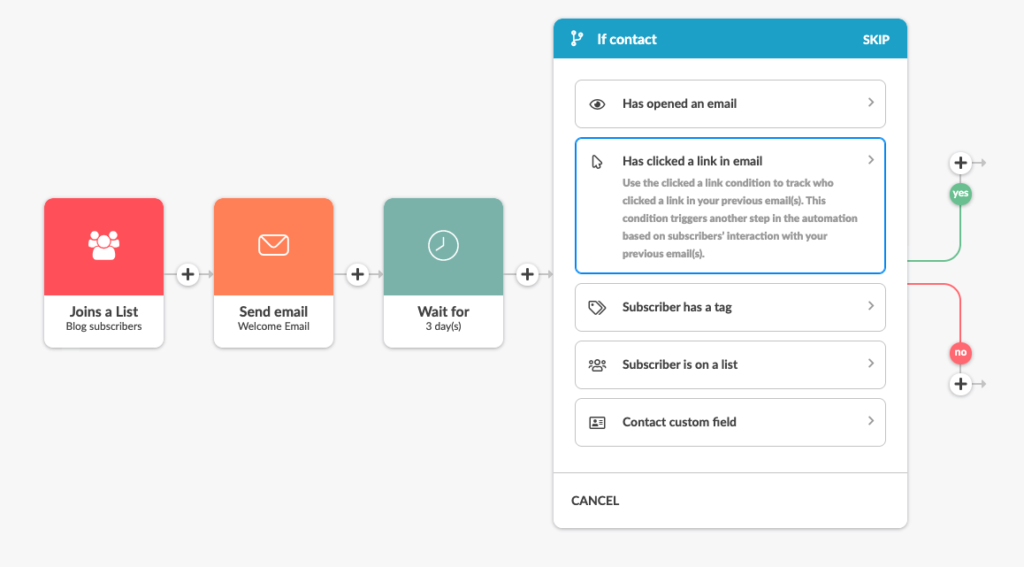
And the whole automation would look like the following with contact tags:
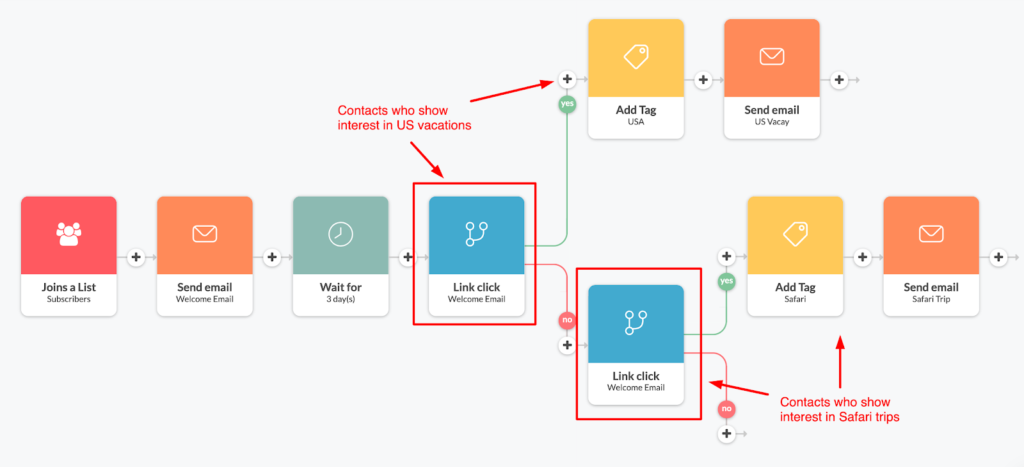
You can use contact tags for better audience targeting in your upcoming promotional bulk campaigns.
A/B testing
A/B testing emails allow you to test your email subject lines on different segments so later on you can decide which one resonates the most with your segment.
For you to understand what works and what doesn’t, A/B test your subject lines.
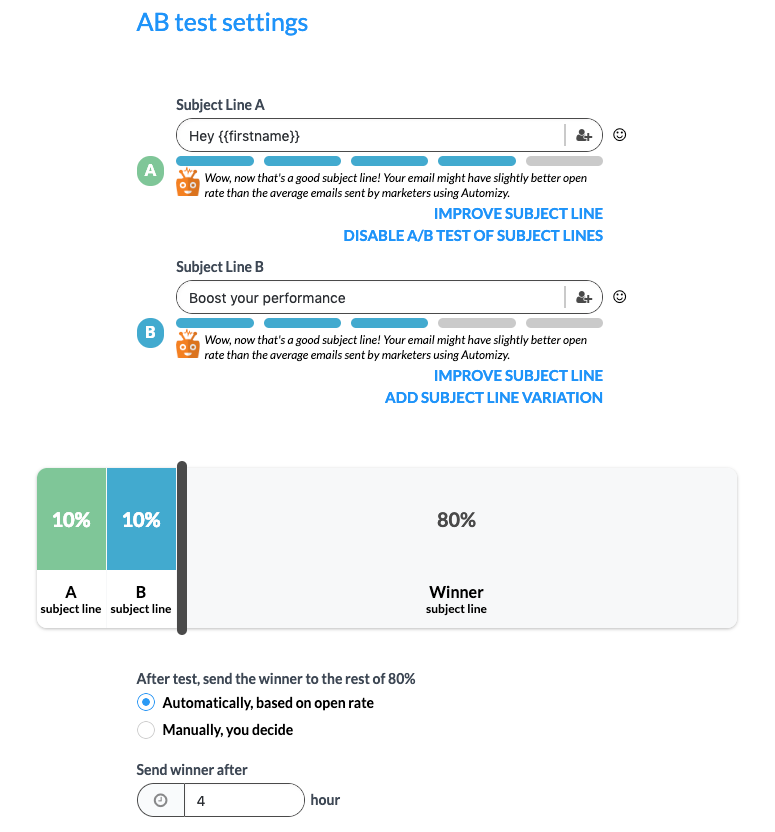
An A/B test measures the engagement for different subject lines.
Filtering subscribers based on engagement
You can also manage your email list based on the engagement of your subscribers and customers.
For instance, you can filter your email database to have a look on your email openers, link clickers, and understand who are your most loyal subscribers.
In Automizy, you can also filter the list of contacts who
- Received or didn’t receive a specific email.
- Opened or didn’t open a specific email.
- Clicked or didn’t click on a link in a specific email.
Engagement contact filtering helps you send targeted email campaigns based on your subscribers’ interaction with your previous campaigns.
Send re-engagement email to reactivate inactive users
One way to reactivating your inactive users is to create a re-engagement email campaign.
Saying goodbye is difficult, yes we know. Re-engagement email campaigns are a second chance for you to win back your subscribers.
A re-engagement email campaign looks like this in Automizy:

To explain what is going on in the workflow:
You send the first email to your contacts, the ones who open your email are your engaged active contacts. In this case, you apply a contact tag ”Engaged” to your email openers.
For contacts who did not open the first email, you send them another email for a second chance to check if they are still interested in what you have to offer.
Then you apply a condition to add “Engaged” tag to your email openers, and a different tag “Unengaged” for contacts who did not open any email of the re-engagement email automation.
Also, make sure to resend emails to non-openers, using different subject lines.
When you resend an email, you shall never forget to write a new subject line. Writing subject lines is not easy, it should never be based on gut feeling and best practices. You might feel positive about your own subject line, your contacts might not.
Automizy’s email subject line generator writes you high-performing subject lines based on the copy of your email.
- Step 1: Copy & paste your email content.
- Step 2: Let Mizy read and analyze it.
- Step 3: Copy, like and use the subject lines you prefer.
In 3 steps, skyrocket your email open rates.
Remove inactive contacts from your email list
Inactive contacts are the contacts who did not show any sign of interest in your re-engagement email campaign.
To remove inactive contacts from your email list you add an action “Remove from list” at the end of your re-engagement campaign.
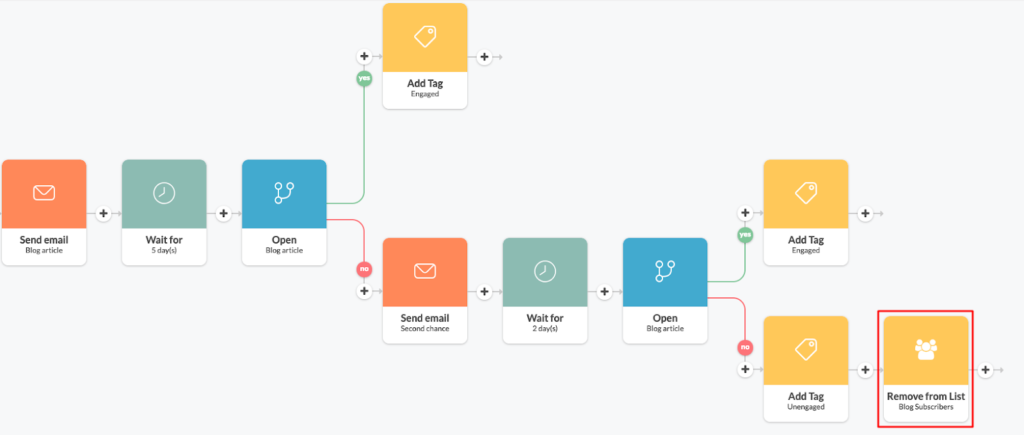
This way, all inactive contacts will be automatically removed from your contact list after showing no sign of interest in your emails.
Note:
Keeping inactive contacts in your email list does influence your email marketing performance. Your email open rates stats particularly.
Email open rate is the percentage of the total number of subscribers who opened an email campaign.
If you have a high number of inactive email subscribers who would never open an email, your email open rates will remain low.
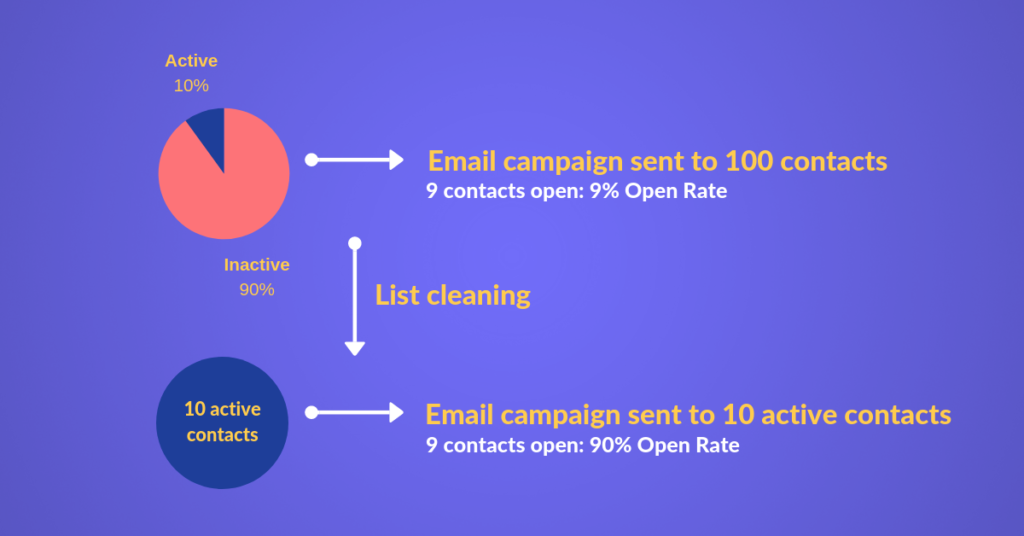
Opt-in email lists
How to manage email subscriptions?
You can create opt-in email lists, so you have different lists depending on which form your website visitors subscribed through.
The Automizy Form Builder is easy and intuitive. You can build your HTML forms on a drag and drop editor and connect it to your email list.
When you are satisfied with it, copy the generated HTML and paste it to the desired place on your web page and you’re done.
Top marketers manage the email list database on autopilot.
Connecting your website forms to your email marketing tool is among the email list management best practices.
How to Build an Email List
Email is without a doubt the most profitable marketing channel there is. And building your email list is non-negotiable regardless of what industry you’re in.
When you’re starting from zero, building a large email list can feel almost impossible sometimes.
For that, you will need to lay-out smart lead generation strategies that work fast.
Here are some ideas on how to capture emails of your website visitors:
- Highlight your most important forms
- Invite visitors to subscribe for your newsletter
- Offer free giveaways
- Offer email-only content
- Display popup forms based on behavior
- Create landing pages
- Use exit-intent popups
Conclusion
Guess who once said, “I love the messy long Excel email lists”? No one.
Managing email lists is a must-do for every business. Organize your contacts database in a way that saves your time, and makes it easy to send emails to a specific target audience.
We hope this guide helps you understand how to manage your email list, and use it in a way that supports sending targeted emails.

